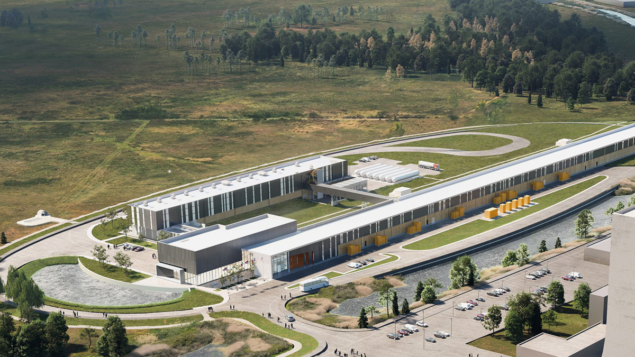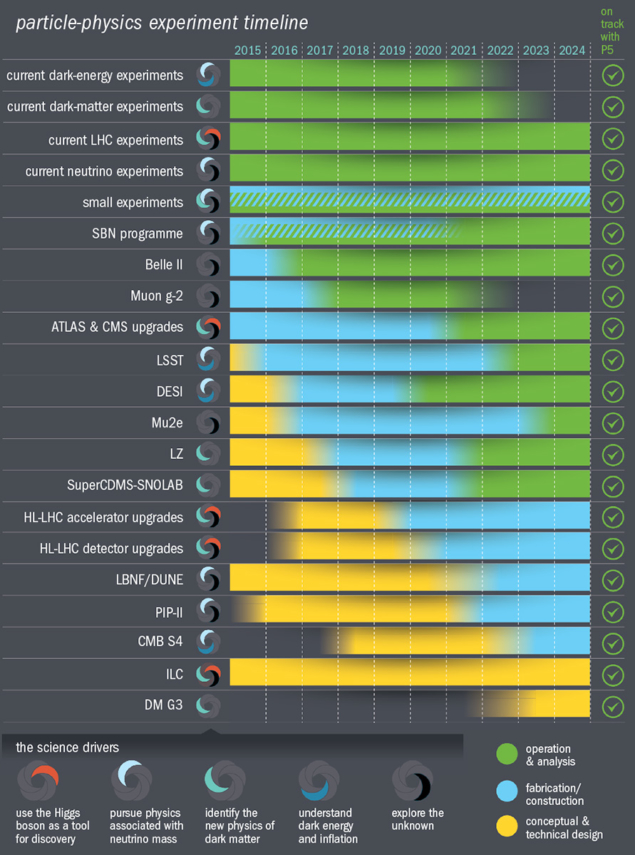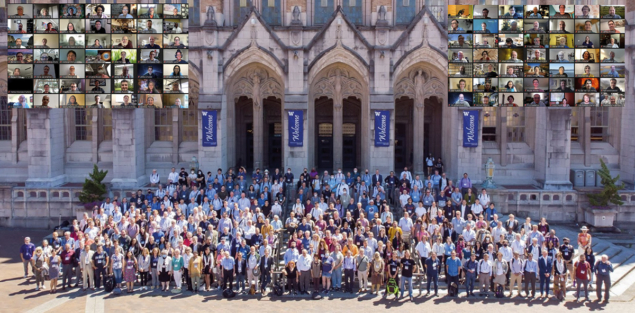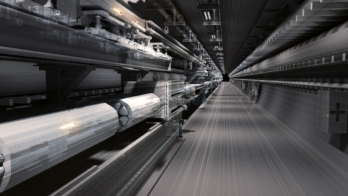The most recent ‘Snowmass’ community planning exercise revealed the great opportunities present in high-energy physics in the coming decades, write Joel Butler, R Sekhar Chivukula, Priscilla Cushman, André de Gouvêa, Tao Han and Young-Kee Kim.

During the past several decades of intense experimental and theoretical research, particle physicists have come to rely on the Standard Model to describe phenomena at the smallest scales and highest energies. This highly predictive, relativistic spontaneously-broken gauge theory has pointed the way to a sequence of discoveries, including that of the W and Z bosons, the gluons, and the charm and top quarks. At each point, it gave us an approximate mass scale or energy range to explore, which told us what kind of facilities we needed to build to observe predicted phenomena. Finally, in 2012, its most remarkable prediction – the existence of a Higgs particle associated with an apparently fundamental scalar field responsible for electroweak symmetry breaking – was confirmed. There are, however, big questions in particle physics to which we don’t know the answers.
Every seven to 10 years since 1982, high-energy physicists in the US have undertaken a community planning exercise to identify the most important questions for the following two decades and the facilities, infrastructure and R&D needed to pursue them. For many years these efforts, which are sponsored by the Division of Particles and Fields (DPF) of the American Physical Society (APS) and include scientists from other countries and related fields, concluded with a summer workshop in Snowmass, Colorado. The planning exercise focuses on scientific issues, whereas establishing project priorities is the task of a Particle Physics Project Prioritization Panel “P5”, charged by the US Department of Energy (DOE) and the National Science Foundation (NSF).
The latest study, “Snowmass 2021” (CERN Courier January/February 2022 p43) was meant to conclude in July 2021, but had to be delayed due to the COVID-19 pandemic. Despite the challenges, our community accomplished an amazing amount of work. The final discussions and synthesis of all the white papers, seminars, workshops and other materials took place at the University of Washington in Seattle from 17–26 July 2022. At the end of the meeting, Hitoshi Murayama (UC Berkeley and the University of Tokyo) was named chairperson of the new P5 subpanel, which will take input from Snowmass 2021.
Snowmass in context
The last US community planning exercise was held in 2013. The subsequent P5 report synthesised the questions identified into five physics drivers: use the Higgs boson as a tool for discovery; pursue the physics associated with neutrino mass; identify the new physics of dark matter; understand cosmic acceleration; and explore the unknown. It also made 29 project-oriented recommendations. The two projects assigned the highest priority were participation in the High-Luminosity LHC and the ATLAS and CMS experiments; and the construction of the LBNF/DUNE long-baseline neutrino experiment, which will detect neutrinos produced at Fermilab interacting in massive underground detectors 1300 km away in the Homestake mine in South Dakota.

Nearly a decade since the last Snowmass/P5 exercise, some elements of the recommended experimental programme have taken data and have succeeded in pushing the boundaries of our knowledge. But despite some hints, they have not yet produced a result that points us in a specific direction. Snowmass 2021 reconfirmed the relevance of the physics drivers, and added a proposal for a sixth: flavour physics as a tool for discovery. Specifically, we don’t understand why three generations of matter particles exist nor the origin of the mass patterns that they exhibit. We do not know why the quark and the lepton mixing matrices are so different, or whether CP violation exists in the neutrino sector and how it relates to the observed matter–antimatter asymmetry of the universe. There are, currently, several tantalising hints of new particles and interactions that could explain various anomalies in the weak decays of B mesons and the anomalous magnetic moment of the muon. Depending on what the near-future brings, dedicated next-generation flavour experiments are likely to be required and could play a key role in the quest for physics beyond the Standard Model.
Snowmass 2021 was organised into 10 working groups or “frontiers”: accelerator, cosmic, community engagement, computational, energy, instrumentation, neutrinos, rare processes and precision measurements, theory, and underground facilities and infrastructure. Each frontier divided its work into several topical groups, taking into account input from the 2020 update of the European strategy for particle physics and other international studies. More than 500 new white papers were produced. An early-career organisation assisted young physicists in contributing to the Snowmass process and international participation was encouraged, with leaders of international institutes and laboratories including Fabiola Gianotti (CERN), Masanori Yamauchi (KEK) and Yifang Wang (IHEP) giving presentations during special plenary sessions at the Seattle workshop. In describing the US programme, Fermilab director Lia Merminga emphasised the importance of international collaboration, citing the close relationship between the US and CERN.
There was broad agreement that a successful future programme should include a healthy breadth and balance of physics topics, experiment sizes and timescales, supported via a dedicated, robust and ongoing funding process. Completion of existing experiments and execution of DUNE and the HL-LHC programmes are critical for addressing the science drivers in the near-term. Strong and continued support for formal theory, phenomenology and computational theory is needed, as are stronger, targeted efforts connecting theory to experiment. Both R&D directed to specific future projects and generic research needs to be supported in critical enabling technologies such as accelerators, instrumentation/detectors and computation, and in new ones such as quantum science and machine learning. Finally, a cohesive, strategic approach to promoting diversity, equity and inclusion, and to improving outreach and engagement, is required.
A panoply of ideas were discussed at Snowmass 2021. Here, in the context of the 10 frontiers, we list some of the larger projects and programmes that are proposed to be carried out, or at least started, in the next two decades, and some important conclusions concerning enabling technologies and infrastructure, with the disclaimer that these may change as the final Snowmass frontier reports are written.
The cosmic frontier
The cosmic frontier is focused on understanding how fundamental physics shapes the behaviour of the universe, in particular concerning the nature of dark matter (DM) and dark energy. The space of DM models encompasses a dizzying array of possibilities representing many orders of magnitude in mass and couplings, making the DM programme one of the most interdisciplinary investigations in high-energy and particle physics. The cosmic frontier DM programme will “delve deep, search wide” by employing a range of direct searches for WIMPs interacting with targets on Earth or produced at accelerators, indirect searches for the products of DM annihilation and probes based on analyses of cosmic structure. A complementary thrust is building the next generation of cosmological probes. The next big project in this arena is CMB-S4, a system of telescopes to study the cosmic microwave background and address the mystery of cosmic inflation, which is expected to operate through to at least 2036 (CERN Courier March/April 2022 p34). Additional projects that would start after 2029 are Spec-S5 (the follow-on spectroscopic device to DESI), a project to carry out line intensity mapping (LIM), and planning efforts to increase the sensitivity of gravity wave detection by at least a factor of 10 (103 in sensitive volume) beyond what will be achieved by LIGO/Virgo.

The energy frontier
The immediate goal for the energy frontier is to carry out the 2014 P5 recommendations to complete the HL-LHC upgrade and execute its physics programme. A new aspect of the proposed programme is the emergence of a variety of auxiliary experiments, examples of which are FASER (operational) and MATHULSA (proposed), that can use the existing LHC interaction regions to explore parts of discovery space in the far-forward regions. These are mid-scale detectors in cost and complexity, and provide room for additional innovation at the HL-LHC. The energy frontier supports the construction of a global e+e– Higgs factory as soon as possible. Either a linear collider or a circular collider can provide the necessary sensitivity, and a programme of directed detector and accelerator R&D for a Higgs factory is needed immediately to enable US participation. To ensure the long-term viability of the field, the energy frontier wants to begin accelerator and detector R&D towards a 10 TeV muon collider or a 100 TeV-scale hadron collider, in collaboration with partners worldwide. Finally, the US energy-frontier community has expressed renewed interest and ambition to develop options for an energy-frontier collider that could be sited in the US, specifically either an e+e– Higgs factory or a muon collider, while maintaining its international collaborative partnerships and obligations with, for example, CERN future-collider R&D projects.
The neutrino frontier
What are the neutrino masses? Are neutrinos their own antiparticles? How are the masses ordered? What is the origin of neutrino mass and flavour? Do neutrinos and antineutrinos oscillate differently? And are there new particles and interactions that can be discovered? These are among the fascinating questions elaborated by the neutrino frontier. The DUNE R&D programme, propelled by the development of large-scale liquid-argon detectors in the US and Europe, in particular through the CERN Neutrino Platform, has demonstrated the power and feasibility of this technique. Following the completion of DUNE Phase 1 by 2030, DUNE Phase 2 is the neutrino community’s highest priority project for 2030–2040. The Phase 2 project has three components: a replacement of the Fermilab 8 GeV Booster to deliver 2.4 MW to the DUNE target and possibly to provide beam for other experiments; the construction of an additional 20 kT (fiducial) of far-detectors at Homestake; and a fully capable near-detector complex at Fermilab to provide very precise control of the systematic uncertainties for the far-detector measurements, besides carrying out a rich physics programme of their own. DUNE will perform definitive studies of neutrino oscillations, test the three-flavour paradigm, search for new neutrino interactions, and will resolve the mass hierarchy question and hopefully observe CP violation. There are many other aspects of neutrino physics that merit study, including the absolute mass, the search for neutrinoless double beta decay (which bears on the issue of whether the neutrino is a Dirac or a Majorana fermion), the measurement of cross sections, and the search for sterile neutrinos. Several of these will be part of the US neutrino programme, either based in the US or through collaboration abroad.
Rare processes and precision measurements
The rare processes and precision measurements frontier is currently working on two mid-sized US projects at Fermilab endorsed by P5 in 2014: the Muon g−2 experiment, which has produced exciting results and will continue to take data for at least a few more years; and the Mu2e experiment, which is under construction. The programme also has important investments in flavour physics through support of the Belle II experiment in Japan and LHCb at CERN. Priorities for the next few years are to complete g−2, begin taking data with Mu2e, and continue collaboration at Belle II and LHCb, including participation in future upgrades. Looking ahead, the central themes are to understand quark and lepton flavour and its violation measurements, and the search for dark-matter production in the mass range from sub-MeV to a few GeV in fixed-target proton and electron experiments. There is a proposal to study muon science in an advanced muon facility at Fermilab that would greatly improve the search for lepton-flavour violation in µ → eγ, µN → eN and µ → 3e decays. This would require an intense proton beam with unique characteristics and accumulator rings to manage the production of muon beams with different energies and time profiles.
Theory frontier
Theoretical particle physics seeks to provide a predictive mathematical description of matter, energy, space and time that synthesises our knowledge of the universe, analyses and interprets existing experimental results and motivates future experimental investigation. Theory connects particle physics to other areas (e.g. gravity and cosmology) and extends the boundaries of our understanding (e.g. quantum information). Together, fundamental, phenomenological and computational theory form a vibrant ecosystem whose health is essential to all aspects of the US high-energy physics programme. The theory frontier recommends, among others, invigorated support for a broad programme of research as part of a balanced portfolio and an emphasis on targeted initiatives to connect theory to experiment.
Nearly a decade since the last Snowmass exercise, the recommended experimental programme has succeeded in pushing the boundaries of our knowledge
Accelerator frontier
The accelerator frontier, which has many crossovers with the energy frontier, aims to prepare for the next generations of major accelerator-based particle physics projects to explore the energy, neutrino and rare-process-and-precision frontiers. In the near term, a multi-MW beam-power upgrade of the Fermilab proton accelerator complex is required for DUNE phase 2. Studies are required to understand what other requirements the Fermilab accelerator complex needs to meet if the same upgrade is to be used for related rare-decay and precision experiments. In the energy frontier, a global consensus for an e+e– Higgs factory as the next collider has been reaffirmed. While some options (e.g. the International Linear Collider) have mature designs, other options (such as FCC-ee, C3, HELEN and CLIC) require further R&D to understand if they are viable. In order to further explore the energy frontier, a very high-energy circular hadron collider or a multi-TeV muon collider will be needed, both of which require substantial study to see if construction is feasible in the decade starting 2040 or beyond. It is proposed that the US establish a national integrated R&D programme on future colliders to carry out technology R&D and accelerator design studies for future collider concepts. Since machines of this magnitude will require international collaboration, the US R&D programme must be well-aligned and consistent with international efforts. Also under consideration are new acceleration techniques, such as wakefield acceleration, and ERLs, along with proposed R&D programmes that could indicate how they would contribute to the design of future colliders.
Computational frontier
Software and computing are essential to all high-energy physics experiments and many theoretical studies. However, computing has entered a new “post-Moore’s law” phase. Speed-ups in processing now come from the use of heterogeneous resources such as GPUs and FPGAs developed in the commercial sector, with significant implications for the way we develop and maintain software. We are also beginning to rely on community hardware resources such as high-performance computing centres and the cloud rather than dedicated experiment resources. Finally, new machine-learning approaches are changing the way we work. This new computing environment requires new approaches to address the long-term development, maintenance and user support of essential software packages and cross-cutting R&D efforts. Additionally, strong investment in career development for software and computing researchers is needed to ensure future success. The computational frontier therefore recommends the creation of a standing coordinating panel for software and computing under the auspices of the APS DPF, mirroring the Coordinating Panel for Advanced Detectors established in 2012.
Instrumentation frontier
Improved instrumentation is the key to progress in neutrino physics, collider physics and the physics of the cosmic and rare-processes frontiers. Many aspects now at the cutting-edge of detector development were hardly present 10 years ago, including quantum sensors, machine-learning and precision timing. Funding for instrumentation in the US, however, is actually declining. Key elements of a rejuvenated instrumentation effort include programmes to develop and maintain a sufficiently large and diverse workforce, including physicists, engineers and technicians at universities and national laboratories; double the US detector R&D budget over the next five years and modify funding models to enable R&D consortia; expand and sustain support for innovative detector R&D and establish a separate review process for such pathfinding endeavours; and develop and maintain critical facilities, centres and capabilities for sharing knowledge and tools.

The underground frontier
Underground experiments address some of the most important areas of particle physics, including the search for dark matter, neutrino physics (including neutrinoless double beta decay and atmospheric neutrinos), cosmic-ray physics and searches for proton decay. The underground frontier concluded that future experiments and their enabling R&D require more space than is currently planned. They proposed a possible addition of the underground space at a depth of 4850 feet at SURF/Homestake and possible additional space at a depth of 7400 feet. These would open up space to develop new experiments and would provide the opportunity for SURF to host next-generation dark-matter or neutrinoless double beta decay experiments.
Community engagement
The community engagement frontier concentrated on seven areas: interaction with industry; career pipeline and development; diversity, equity and inclusion; physics education; public education and outreach; public policy and government engagement; and environmental and societal impacts. The inclusion of this broad array of issues as a “frontier” was a novel aspect of Snowmass 2021 and led to the formulation of many proposals for consideration and implementation by the community as a whole. These issues impact the ability of all frontiers to successfully complete their work, and some, such as the need to broaden representation, are highlighted by other frontiers too. While many recommendations apply directly to the DOE and NSF programmes and could be considered by P5, many others are directed to the HEP community as a whole. We in DPF are considering how best to pursue these issues with government agencies, APS and other groups.
The exciting road ahead
Almost three months since the Seattle workshop, the individual frontier reports are now nearly all complete and the process of synthesising the results has begun. One important theme is to stay the course on the programme approved by the last P5 in the hopes that the hints and anomalies that have shown up since then will provide some guidance for physics beyond the Standard Model. The second theme is that, in the absence of a specific target, we will have to plan a very diverse programme of experiments, theoretical studies and machine and detector R&D in which we broadly explore the large space of possibilities. In all cases, a global effort will be required, and much thought is being applied to ensuring that the US can play an appropriate role.
A global effort will be required, and much thought is being applied to ensuring that the US can play an appropriate role
We believe that members of the US high-energy physics community left the Seattle workshop with an appreciation of the great opportunities present in each frontier, the interconnections between the frontiers and the connections to programmes in the rest of the world. We hope that our report will help P5 produce recommendations that we can unite behind, as we did in 2014. That has proven to be an effective step in convincing the public and policy makers that we have conducted a rigorous process and achieved a consensus that is worthy of their support.





